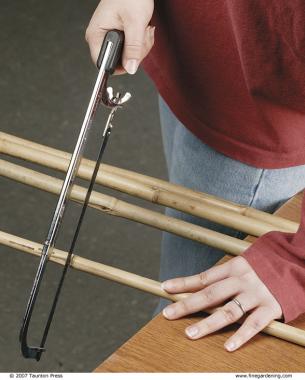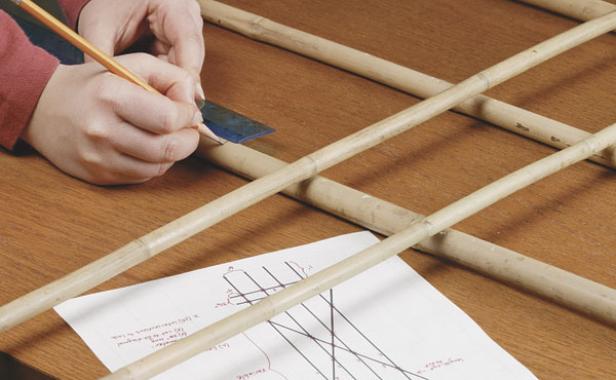
The number of vines on my garden wish list will soon outnumber the structures on which I can grow them. Is that a bad thing, you ask? It would be if I had to rely on the vine supports for sale at local nurseries and home stores. What I found on a recent shopping trip was either overpriced, lacking in character, or made with flimsy materials. That’s what motivated me to make my own trellises out of bamboo. Bamboo is a wonderfully versatile building material and one of the world’s most renewable resources. It’s lightweight, strong, and flexible, and it looks at home in most gardening schemes, even in the garden that surrounds my late-19th-century in-town house. Another plus is that bamboo can last 8 to 10 years before showing signs of deterioration.
One of the benefits of designing and building my own trellises is that I can determine their size. Furthermore, I can work with two cane widths to give my designs more visual interest. To tie the bamboo together, I use a wax-coated black lashing cord that contrasts nicely with the buff-colored bamboo. I mail-order bamboo in bulk to save money and to have extra on hand for other projects. With an investment of less than two hours and for about $10, I have a custom-made trellis for one of the vines in my growing collection.
Supplies
• Lashing cord
• Hand saw
• Ruler or tape measure
• Pencil
1. Create a design

Imagine your trellis where it will eventually be placed, taking into account the size and shape of the area where it will be situated. Draw the design of your trellis on paper. Deciding on as many measurements as possible in advance will help you to stay on track during the building process.
2. Cut the bamboo to size


Use a hand saw to cut the sky-facing ends of your vertical canes just above a node, which is solid. This will keep water from collecting in the open ends, which would encourage rot. Then cut the trimmed canes to size from the bottom. Cut the horizontal canes to size as well.

3. Lay out your trellis

On a flat surface, arrange the canes into the shape of your design, using a ruler to ensure that the canes are spaced evenly. Mark the intersecting points of the crossing canes with a pencil, since the unbound canes will shift around a bit as you start to connect them with lashing cord.
4. Lash it together

Using the technique pictured below, lash the crossing canes together as tightly as possible.
Try this lashing technique

More on lashing and trellises . . .
Learn Lashing and Make Your Own Garden Trellises on VegetableGardener.com.
Fine Gardening Recommended Products

A.M. Leonard Deluxe Soil Knife & Leather Sheath Combo
Fine Gardening receives a commission for items purchased through links on this site, including Amazon Associates and other affiliate advertising programs.

Ho-Mi Digger - Korean Triangle Blade
Fine Gardening receives a commission for items purchased through links on this site, including Amazon Associates and other affiliate advertising programs.

The Crevice Garden: How to make the perfect home for plants from rocky places
Fine Gardening receives a commission for items purchased through links on this site, including Amazon Associates and other affiliate advertising programs.



















Comments
So, how do you keep the trellis from falling over? Do you bury part of the trellis, if so, how much?
If you happen to live in an area where Arundo donax ("Giant Reed") is an invasive you may be able to harvest Arundo canes in various diameters, dry them thoroughly in direct sun for several months and then use those to make trellises instead of store purchased bamboo. I've used Arundo harvested from a patch we are working to remove from a local riparian area as supports in the vegetable garden for years. Be sure it is completely dry and dead before putting it in the ground. If it still has live buds it will quickly sprout...as when our local levee weed abatement crews cut the stuff from river banks and leave the stalks in the water. Within days there are bright green rafts of new sprouts of Arundo drifting everywhere...and happily re-establishing downstream. By using Arundo in place of bamboo it will save a little on the cost of each trellis and may help remove a noxious invasive from a riparian area near you.
Log in or create an account to post a comment.
Sign up Log in